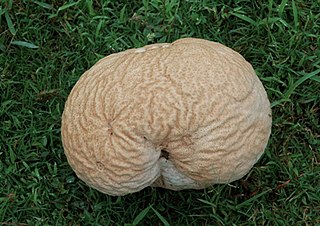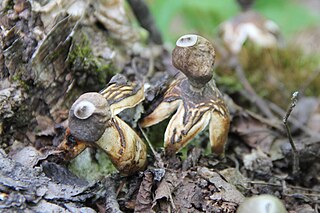
Puffballs are a type of fungus featuring a ball-shaped fruit body that bursts on contact or impact, releasing a cloud of dust-like spores into the surrounding area. Puffballs belong to the division Basidiomycota and encompass several genera, including Calvatia, Calbovista and Lycoperdon. The puffballs were previously treated as a taxonomic group called the Gasteromycetes or Gasteromycetidae, but they are now known to be a polyphyletic assemblage.

Lycoperdon perlatum, popularly known as the common puffball, warted puffball, gem-studded puffball or devil's snuff-box, is a species of puffball fungus in the family Agaricaceae. A widespread species with a cosmopolitan distribution, it is a medium-sized puffball with a round fruit body tapering to a wide stalk, and dimensions of 1.5 to 6 cm wide by 3 to 10 cm tall. It is off-white with a top covered in short spiny bumps or "jewels", which are easily rubbed off to leave a netlike pattern on the surface. When mature it becomes brown, and a hole in the top opens to release spores in a burst when the body is compressed by touch or falling raindrops.

The Sclerodermataceae are a family of fungi in the order Boletales, containing several genera of unusual fungi that little resemble boletes. Taxa, which include species commonly known as the ‘hard-skinned puffballs’, ‘earthballs’, or 'earthstars', are widespread in both temperate and tropical regions. The best known members include the earthball Scleroderma citrinum, the dye fungus Pisolithus tinctorius and the 'prettymouths' of the genus Calostoma.

Calvatia craniiformis, commonly known as the brain puffball or the skull-shaped puffball, is a species of puffball fungus in the family Agaricaceae. It is found in Asia, Australia, and North America, where it grows on the ground in open woods. Its name, derived from the same Latin root as cranium, alludes to its resemblance to an animal's brain. The skull-shaped fruit body is 8–20 cm (3–8 in) broad by 6–20 cm (2–8 in) tall and white to tan. Initially smooth, the skin (peridium) develops wrinkles and folds as it matures, cracking and flaking with age. The peridium eventually sloughs away, exposing a powdery yellow-brown to greenish-yellow spore mass. The puffball is edible when the gleba is still white and firm, before it matures to become yellow-brown and powdery. Mature specimens have been used in the traditional or folk medicines of China, Japan, and the Ojibwe as a hemostatic or wound dressing agent. Several bioactive compounds have been isolated and identified from the brain puffball.

Calostoma is a genus of 29 species of gasteroid fungi in the suborder Sclerodermatineae. Like other gasteroid fungi, Calostoma do not have the spore discharge mechanism associated with typical gilled fungi (ballistospory), and instead have enclosed spore-bearing structures. Resembling round puffballs with raised, brightly colored spore openings (ostioles), elevated on a thick, gelatinous stalks, species have been collected in regions of deciduous, temperate, tropical or subtropical forests. Their distribution includes eastern North America, Central America, Asia, and Australasia. The common name given to some species, "prettymouth", alludes to the brightly colored raised openings (ostioles) that may somewhat resemble lips. Other common names include "hotlips" and "puffball in aspic".

Bovista is a genus of fungi commonly known as the true puffballs. It was formerly classified within the now-obsolete order Lycoperdales, which, following a restructuring of fungal taxonomy brought about by molecular phylogeny, has been split; the species of Bovista are now placed in the family Agaricaceae of the order Agaricales. Bovista species have a collectively widespread distribution, and are found largely in temperate regions of the world. Various species have historically been used in homeopathic preparations.

Clathrus ruber is a species of fungus in the family Phallaceae, and the type species of the genus Clathrus. It is commonly known as the latticed stinkhorn, the basket stinkhorn, or the red cage, alluding to the striking fruit bodies that are shaped somewhat like a round or oval hollow sphere with interlaced or latticed branches. The species was illustrated in the scientific literature during the 16th century, but was not officially described until 1729.

Handkea utriformis, synonymous with Lycoperdon utriforme, Lycoperdon caelatum or Calvatia utriformis, is a species of the puffball family Lycoperdaceae. A rather large mushroom, it may reach dimensions of up to 25 cm (10 in) broad by 20 cm (8 in) tall. It is commonly known as the mosaic puffball, a reference to the polygonal-shaped segments the outer surface of the fruiting body develops as it matures. Widespread in northern temperate zones, it is found frequently on pastures and sandy heaths, and is edible when young. H. utriformis has antibiotic activity against a number of bacteria, and can bioaccumulate the trace metals copper and zinc to relatively high concentrations.

Geastrum pectinatum is an inedible species of mushroom belonging to the earthstar family of fungi. Although young specimens are spherical, fruit body development involves the outer layer of tissue splitting open like a star into 7 to 10 pointed rays that eventually bend back to point downward, revealing a small – 1 to 2.5 cm broad – spore sac. The spore sac is supported by a small radially wrinkled stalk. There is a distinct conical opening (peristome) at the top of the spore sac that is up to 8 mm long. It is commonly known as the beaked earthstar or the beret earthstar, in reference to the shape of the spore sac and its prominent, protruding peristome. The mass of spores and surrounding cells within the sac, the gleba, is dark-brown, and becomes powdery in mature specimens. Spores are spherical, measuring 4 to 6 micrometers in diameter, with warts on their surfaces.

Bovista aestivalis is a species of small puffball in the family Agaricaceae. It is generally found in the coastal regions of California, but was reported from Korea in 2015. This fungus is often confused with Bovista dermoxantha, because of its similar peridium, and Bovista plumbea. The surest way to tell the species apart is to examine the spores and exoperidium, respectively, with a microscope.

Geastrum triplex is a fungus found in the detritus and leaf litter of hardwood forests around the world. It is commonly known as the collared earthstar, the saucered earthstar, or the triple earthstar—and less commonly by the alternative species name Geastrum indicum. It is the largest member of the genus Geastrum and expanded mature specimens can reach a tip-to-tip length of up to 12 centimeters.
Limnoperdon is a fungal genus in the monotypic family Limnoperdaceae. The genus is also monotypic, as it contains a single species, the aquatic fungus Limnoperdon incarnatum. The species, described as new to science in 1976, produces fruit bodies that lack specialized structures such as a stem, cap and gills common in mushrooms. Rather, the fruit bodies—described as aquatic or floating puffballs—are small balls of loosely interwoven hyphae. The balls float on the surface of the water above submerged twigs. Experimental observations on the development of the fruit body, based on the growth on the fungus in pure culture, suggest that a thin strand of mycelium tethers the ball above water while it matures. Fruit bodies start out as a tuft of hyphae, then become cup-shaped, and eventually enclose around a single chamber that contains reddish spores. Initially discovered in a marsh in the state of Washington, the fungus has since been collected in Japan, South Africa, and Canada.

Calbovista is a fungal genus containing the single species Calbovista subsculpta, commonly known as the sculptured puffball, sculptured giant puffball, and warted giant puffball. It is a common puffball of the Rocky Mountains and Pacific Coast ranges of western North America. The puffball is more or less round with a diameter of up to 15 cm (6 in), white becoming brownish in age, and covered with shallow pyramid-shaped plates or scales. It fruits singly or in groups along roads and in open woods at high elevations, from summer to autumn.

Lycoperdon echinatum, commonly known as the spiny puffball or the spring puffball, is a type of puffball mushroom in the family Agaricaceae. The saprobic species has been found in Africa, Europe, Central America, and North America, where it grows on soil in deciduous woods, glades, and pastures. It has been proposed that North American specimens be considered a separate species, Lycoperdon americanum, but this suggestion has not been followed by most authors. Molecular analysis indicates that L. echinatum is closely related to the puffball genus Handkea.

Agaricus deserticola, commonly known as the gasteroid agaricus, is a species of fungus in the family Agaricaceae. Found only in southwestern and western North America, A. deserticola is adapted for growth in dry or semi-arid habitats. The fruit bodies are secotioid, meaning the spores are not forcibly discharged, and the cap does not fully expand. Unlike other Agaricus species, A. deserticola does not develop true gills, but rather a convoluted and networked system of spore-producing tissue called a gleba. When the partial veil breaks or pulls away from the stem or the cap splits radially, the blackish-brown gleba is exposed, which allows the spores to be dispersed.

Geastrum quadrifidum, commonly known as the rayed earthstar or four-footed earthstar, is an inedible species of mushroom belonging to the genus Geastrum, or earthstar fungi. First described scientifically by Christian Hendrik Persoon in 1794, G. quadrifidum is a cosmopolitan—but not common—species of Europe, the Americas, Africa, Asia, and Australasia. The fungus is a saprobe, feeding off decomposing organic matter present in the soil and litter of coniferous forests.

Scleroderma polyrhizum, commonly known as the star earthball or dead man's hand, is a basidiomycete fungus and a member of the genus Scleroderma, or "earthballs". Found in dry, sandy soils, this species begins completely buried before slowly forcing the soil aside as it cracks apart to form a rough, star-shaped body with a diameter of 12–15 cm (4.7–5.9 in). At the center is the dark, brownish spore mass. Widely distributed wherever the soil and climate are favorable, it is known from Asia, Europe, and the Americas.

Sclerodermatineae is a suborder of the fungal order Boletales. Circumscribed in 2002 by mycologists Manfred Binder and Andreas Bresinsky, it contains nine genera and about 80 species. The suborder contains a diverse assemblage fruit body morphologies, including boletes, gasteroid forms, earthstars, and puffballs. Most species are ectomycorrhizal, although the ecological role of some species is not known with certainty. The suborder is thought to have originated in the late Cretaceous (145–66 Ma) in Asia and North America, and the major genera diversified around the mid Cenozoic (66–0 Ma).

Bovista pila, commonly known as the tumbling puffball, is a species of puffball fungus in the family Agaricaceae. A temperate species, it is widely distributed in North America, where it grows on the ground on road sides, in pastures, grassy areas, and open woods. There are few well-documented occurrences of B. pila outside North America. B. pila closely resembles the European B. nigrescens, from which it can be reliably distinguished only by microscopic characteristics.

Calvatia pachyderma, also known as the elephant-skin puffball or thick-skinned puffball, is a species of edible fungus. This mid-sized, spring-fruiting puffball is known from relatively dry, open places near human settlements. The appropriate binomial name, taxonomic placement, and geographic distribution "have been much debated and are the subject of controversy".






















